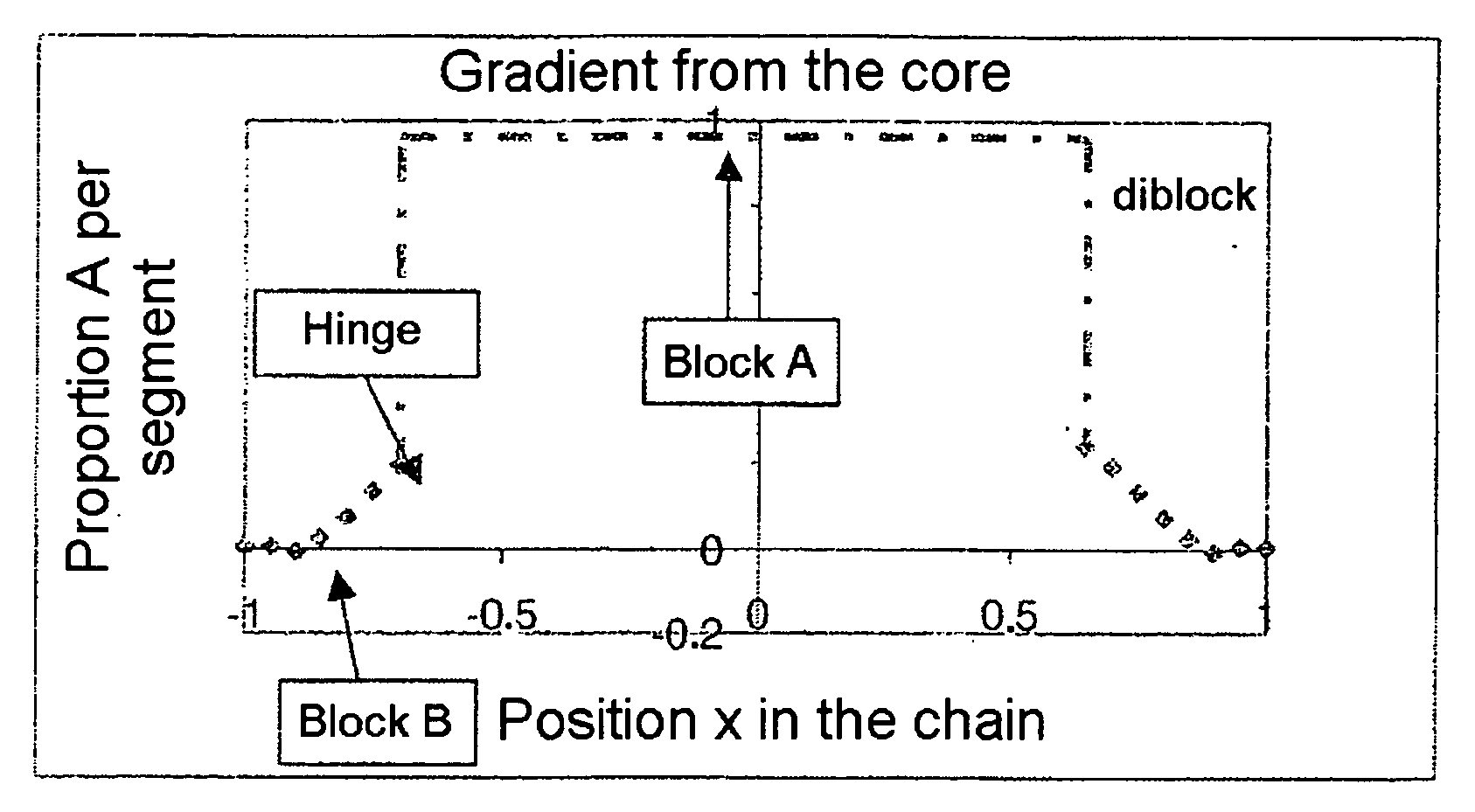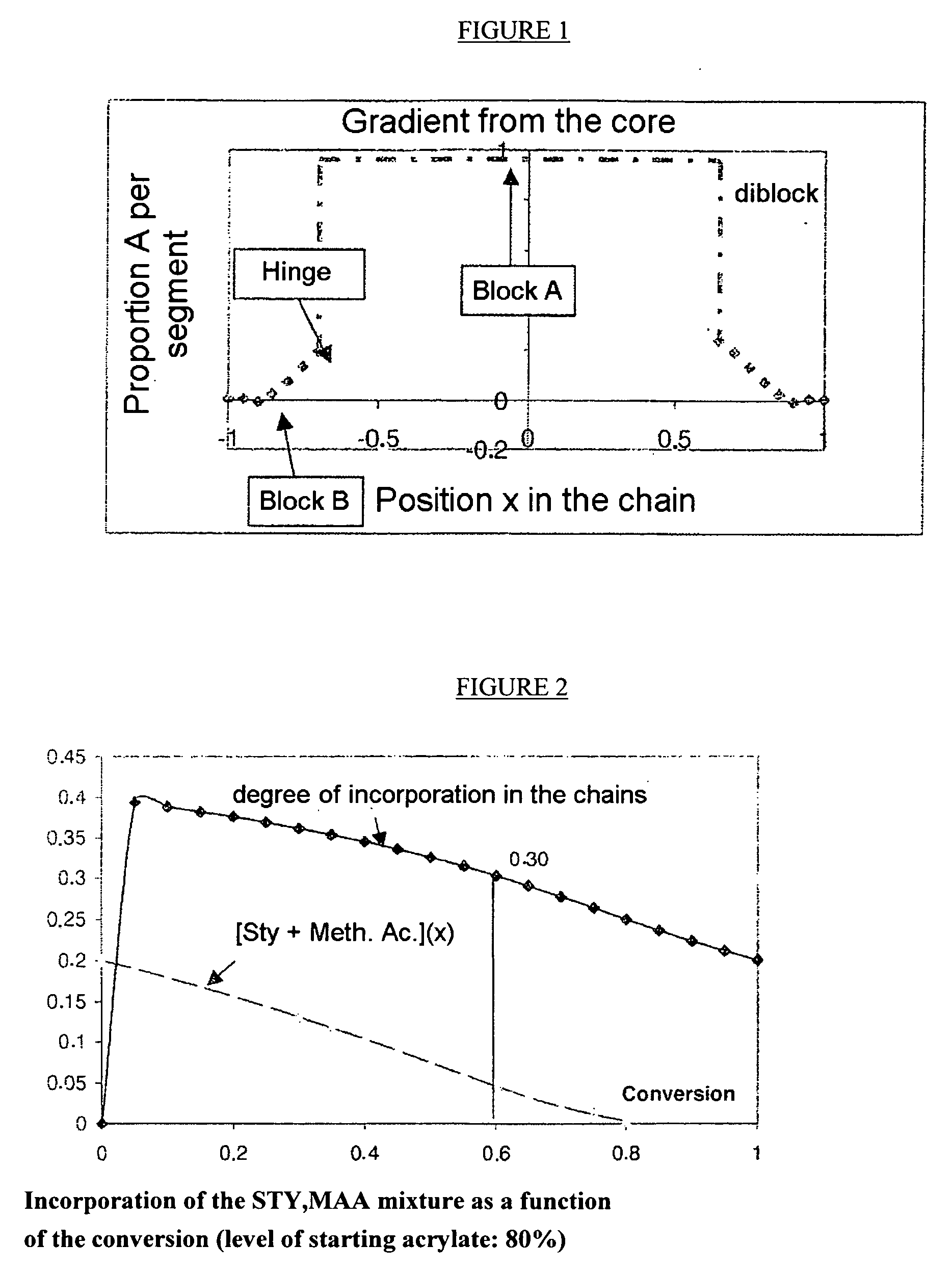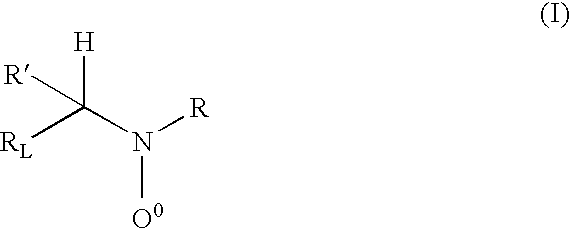Gradient copolymers soluble or at least dispersible in water as well as in organic solvents
a gradient copolymer and amphiphilic technology, applied in the field of amphiphilic gradient copolymers, can solve the problems of high viscosity of polymers, difficult, even impossible, to dissolve such polymers in aqueous solution or in solvents
- Summary
- Abstract
- Description
- Claims
- Application Information
AI Technical Summary
Problems solved by technology
Method used
Image
Examples
example 1
Bulk Synthesis of Gradient Copolymer
[0094] The mixture of reactants is as follows:
MONAMS: 3.0 gSG1: 0.18 gEthyl acrylate (EA): 480 gi.e. 80% by weight / total weight ofmonomersStyrene (S): 60 gi.e. 10% by weight / total weight ofmonomersMethacrylic acid (MAA): 60 gi.e. 10% by weight / total weight ofmonomers
[0095] All the constituents are mixed, in the absence of solvent, under a nitrogen atmosphere, and are then heated at a temperature maintained between 110 and 115° C. for 198 minutes.
[0096] The calculation of the gradient by simulation gives the curve in FIG. 2. The validity of this model is given by the monitoring of the relative concentrations of the three monomers by gas chromatography and NMR analysis of the polymers.
[0097] It is found that, at 60% conversion, the chemical composition of the copolymer is: 68.4% ethyl acrylate, 16.1% styrene and 15.5% methacrylic acid, according to NMR on the calculated curve (69%).
[0098] STY and MAA in the above figure respectively indicate S...
example 2
Bulk Synthesis of Gradient Copolymer
[0106] Different copolymers were prepared, according to the procedure described in example 1, from the following mixture of reactants: [0107] MONAMS: 3.0 g [0108] SG1: 0.18 g [0109] Styrene: 60 g [0110] Methacrylic acid: 60 g
[0111] Acrylate (or mixture of acrylate): 480 g
Final compositionCharacteristics of theof the copolymerExampleAcrylatecopolymer(% by weight)2aButyl acrylateMn = 31 100 g / molStyrene: 18(BuA)Mw = 52 930 g / molMethacrylicacid: 22PI = 1.7Butylacrylate: 602bMethyl acrylateMn = 32 750 g / molStyrene: 20(MeA)Mw = 61 470 g / molMethacrylicacid: 21PI = 1.88Methylacrylate: 592c50 / 50 by weightMn = 29 690 g / molStyrene: 18butyl acrylate / Mw = 51 630 g / molMethacrylicethyl acrylateacid: 16(EA) mixturePI = 1.74Acrylates: 66
example 3
Synthesis in the Presence of Solvent
[0112] The same synthesis is carried out as in example 1 but in the presence of solvent. The mixture of reactants is as follows: [0113] MONAMS: 3.43 g [0114] SG1: 0.2 g [0115] Ethyl acrylate: 336 g [0116] Styrene: 42 g [0117] Methacrylic acid: 42 g [0118] Toluene: 180 g
[0119] All the constituents are mixed, in toluene as solvent, under a nitrogen atmosphere, and are then heated at a temperature maintained between 110 and 115° C. for 198 minutes.
[0120] The final degree of conversion is 82% and the level of solid obtained is 57.2% by weight.
[0121] The analytical results below are determined: [0122] Mn=30 570 g / mol, Mw=50 500 g / mol and PI=1.65.
[0123] The final composition of the copolymer is given by liquid absorption chromatography (LAC), which shows the similarity in composition with the copolymer prepared in example 1 and the absence of homopolymer in the materials. This is illustrated by curve 1 above given in example 1.
PUM
| Property | Measurement | Unit |
|---|---|---|
| polydispersity index | aaaaa | aaaaa |
| polydispersity index | aaaaa | aaaaa |
| temperature | aaaaa | aaaaa |
Abstract
Description
Claims
Application Information
 Login to View More
Login to View More - R&D
- Intellectual Property
- Life Sciences
- Materials
- Tech Scout
- Unparalleled Data Quality
- Higher Quality Content
- 60% Fewer Hallucinations
Browse by: Latest US Patents, China's latest patents, Technical Efficacy Thesaurus, Application Domain, Technology Topic, Popular Technical Reports.
© 2025 PatSnap. All rights reserved.Legal|Privacy policy|Modern Slavery Act Transparency Statement|Sitemap|About US| Contact US: help@patsnap.com



